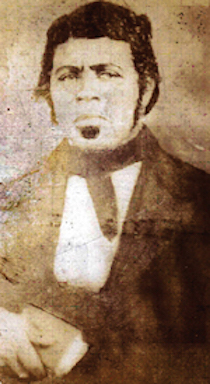
Paul Jennings was a personal servant and slave to President James Madison during and after his White House years. After buying his freedom in 1845 from Daniel Webster, Jennings in 1865 published the first White House memoir, A Colored Man’s Reminiscences of James Madison. Jennings was born into slavery in 1799 at Montpelier, the Madison plantation near Orange, Virginia. His mother was a household slave of African-Native American descent, and his father was an English merchant named either Benjamin or William Jennings.
When James Madison became President in 1809, ten-year-old Jennings was chosen to be a footman in the president’s mansion, which would later be known as the White House. In 1814 during the burning of Washington, as British troops were approaching the White House, Jennings at the age of fifteen, along with two other men, helped save the noted Gilbert Stuart painting of George Washington known as the Lansdowne portrait. In his memoir, he wrote that he, a French cook, and one other person took down the painting.
After President Madison ended his second term in office, the Madisons and Jennings returned to Montpelier in 1817. Jennings, who was now eighteen years, married Fanny, a slave held on another plantation. The couple had five children. Jennings was with James Madison when he died in 1836. In 1837 former First Lady Dolly Madison took Jennings with her when she returned to Washington, D.C to live in the winter seasons. This separation forced Jennings to leave his family behind, although he occasionally visited them.
In 1841 Dolly Madison wrote in her will that Jennings would be the only one of the family slaves freed upon her death. In 1844, however, Madison sold Montpelier and all of its property including its slaves, except Jennings, to support herself. That same year, Jennings’s wife, Fanny, died in Virginia. In 1845 Madison hired out Jennings to the new president, James Polk, keeping the earnings made while he worked again at the White House.
In 1846 Madison sold Jennings to Pollard Webb, an insurance agent, for $200. Six months later, Webb sold him to Massachusetts Senator Daniel Webster for $120. Webster immediately freed Jennings. In 1848 Jennings helped plan the unsuccessful escape of 77 slaves from Washington, D.C. in what would be known as the Pearl Incident. The following year, Jennings married Desdemona Brooks, a free mulatto from Alexandria, Virginia.
In the 1850s, Jennings was able to reconnect with his children, John, Franklin, and William and his daughter, Mary. The sons would later join the Union Army in the American Civil War. After the war, Jennings worked at the newly established Pension Bureau part of the Department of the Interior to handle claims of veterans and soldiers’ families. While there, he met John Brooks Russell who persuaded Jennings to publish his memoir, A Colored Man’s Reminiscences of James Madison in 1865.
Jennings bought a lot and house at 1804 L Street NW, and his son John lived with him. His daughter Mary lived next door with her two children. His sons Franklin and William also lived in the area. After Desdemona’s death, Jennings married a third time in 1870 to Amelia Dorsey. Paul Jennings died in Washington, D.C. in 1874 at the age of seventy-five.

